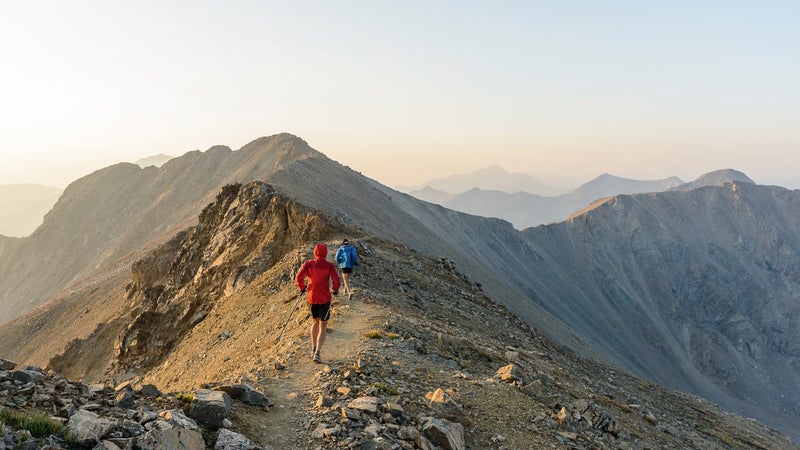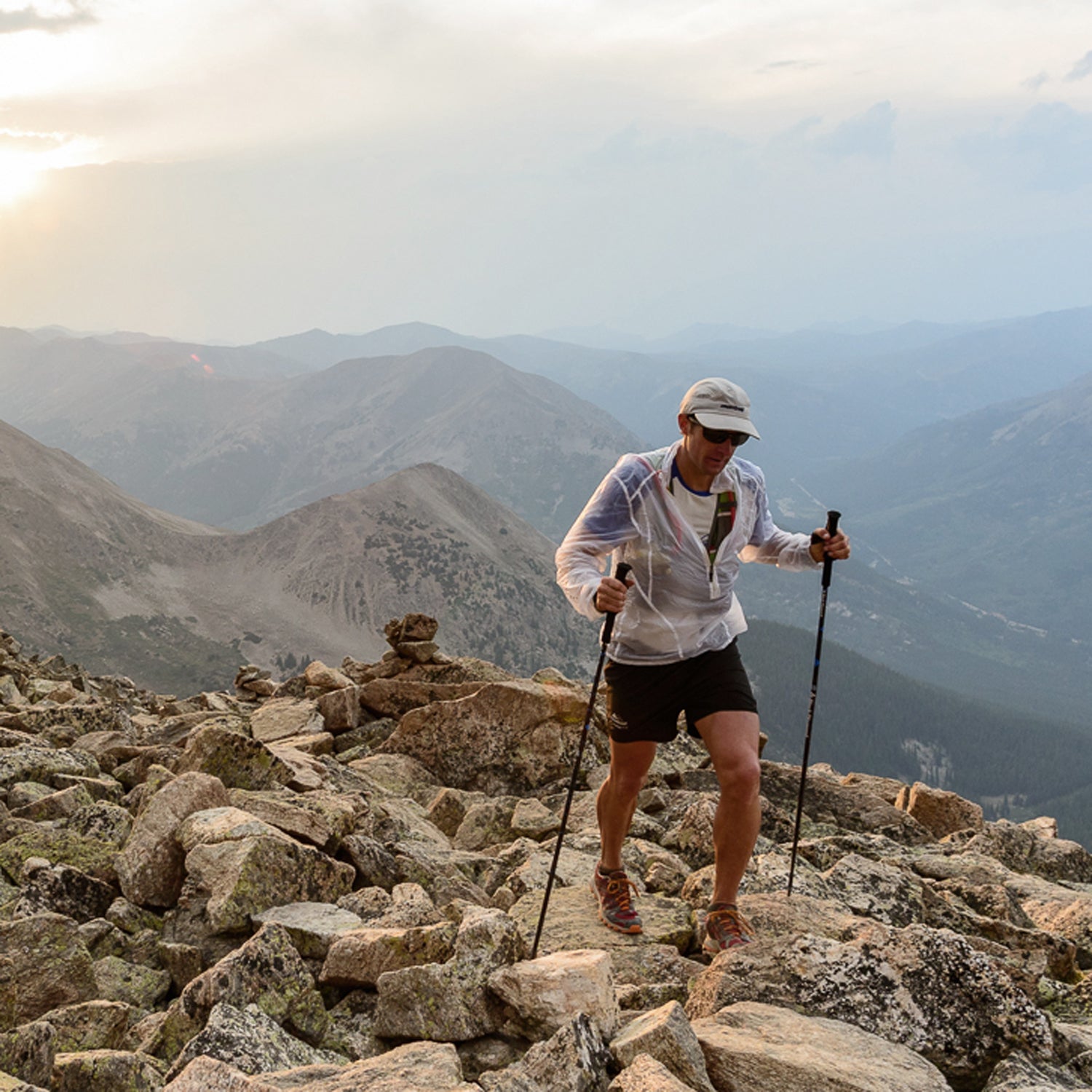“I think he probably needs to go to the hospital,” I quietly said to our crew in the Blank Cabin parking lot.
This was in 2012, and my partner, renowned ultrarunner Jared Campbell, and I had just completed a slog of 58 hours and 58 minutes through Colorado’s Sawatch Mountains. We’d covered about 106 miles, gained more than 44,000 feet in elevation, summited 14 peaks above 14,000 feet, and notched our names as the fifth and sixth athletes to have completed the Nolan’s 14 route since its inception in 1991.
After hours of stumbling through the bush, Campbell’s sunken cheeks, filthy yellow La Sportiva jersey, and sinewy body made him look as if he’d just emerged from being lost in the wilderness for months. He looked like he needed a trip to the emergency room and an I.V. That isn’t to say I had fared any better. I had nearly quit, just three peaks into the run. My lack of altitude training and Campbell’s superior climbing speed left me weak and wondering out loud if I should stop so he could move faster. “You can do something special on this route,” I told him. “Just go without me.”
He refused, instead insisting we continue together, running ourselves into the ground. Why?
Humans are hardwired for adventure. Taking risks ignites the brain’s arousal and pleasure mechanisms, offering a dopamine response similar to drugs. So we push farther, faster. It’s an evolutionary advantage. Early hominids—who ventured far from home, swam to the island on the horizon, and trekked all day to find a new water source to keep the tribe from starving—risked dying just to survive. But their efforts often paid off, and made, for many of us, adventure-seeking an ingrained part of our humanity. It’s why we become euphoric when a new landscape unveils itself from the top of a mountain we’ve never climbed. Food security and modernity have done nothing to diminish our need for novelty and adventure.
Sanctioned events—even ultramarathons on beautiful singletrack—lack a certain aesthetic appeal. Medical teams, aid stations, course markings, and other runners are there to make sure everything is okay. But what if you want to flirt with that line where you aren’t sure everything is okay? What if you know true adventure comes from fear and uncertainty?
As Campbell and I learned, Nolan’s route is a test piece for finding the limits of human physiology. “Nolan’s is right at the margin of what is possible,” said Blake Wood, 56, of Los Alamos, New Mexico. Wood and Campbell remain the only two people ever to have finished three of the hardest ultrarunning chores in the same year: the Barkley Marathons, Hardrock 100 Endurance Run, and Nolan’s 14.

Where races are contrived to ensure that as many people as possible arrive happy and healthy at the finish line, more and more people are foregoing the race scene for the aesthetic of wilder lines and fastest known times (FKTs). “With my climbing background, I find trail racing in the United States boring,” said Campbell. “For me, there are very few 100-mile ultras that are intriguing.”
This year alone, Nolan’s has seen 19 known attempts. The route—which starts west of Leadville, Colorado, and finishes at the trailhead of Mount Shavano—was the brainchild of ultrarunners Fred Vance and Jim Nolan. In 1991, Vance challenged Nolan to see how many 14ers he could fit into a roughly 100-mile route. Nolan, who had climbed all of Colorado’s 54 peaks over 14,000 feet, returned a week later with what we now know as the “Nolan’s 14,” a logical north-south line connecting all but one peak in the Sawatch Range. With no trails between the peaks, bushwhacking and off-trail travel make up the majority of the route. Vance and Nolan then made sleep deprivation mandatory by adding a 60-hour cutoff to be considered an “official” finisher.
The idea languished for eight years before the first efforts were attempted. In 1999, four “Hardrockers” gathered to share moral support, route beta, and support crews in a loosely organized event. Nobody finished. “We were using FRS radios to communicate and help each other with route finding,” said Wood.
Once the best routes had been flushed out through multiple failed attempts, Nolan’s became possible in one push. In 2001, four of the 11 starters—Mike Tilden, Blake Wood, John Robinson, and Jim Nelson—accomplished the feat. To date, John Robinson, 48, of Portland, Oregon, is the only athlete to complete the route twice. His second finish, in 2002, resulted in the current FKT of 54 hours, 57 minutes. In 2003, threats from the U.S. Forest Service to ticket and fine anyone racing the peaks in an organized fashion put an end forever to Nolan’s as an organized event. However, there is nothing stopping a hearty individual from legally setting out into the Sawatch on their own volition.
Spurred by a trickle of new finishers and a high profile failed attempt, the run has flourished in the past few years. This year’s flurry of attempts from July to September resulted in four finishers of the iconic line along the Sawatch. On August 29, Gavin McKenzie, 30, of Leadville, Colorado, and Brandon Stapanowich, 29, of Manitou Springs, Colorado, traveled together and finished in 56 hours, 19 minutes. The very next day, Brandon Worthington, 29, of Aurora, Colorado, emerged as the only finisher in a group of starters who shared resources, sneaking in just under the cutoff at 59 hours, 24 minutes.
Easily the most impressive effort, however, came from Andrew Hamilton, 39, of Denver, Colorado, who completed the route without a support crew. Hamilton, who set the speed record for climbing all of the Colorado 14ers in 2009, carried everything he’d need from the start, getting only available water along the way, and finished on September 12 in an astounding 60 hours, 19 minutes.
Modern-day adventure has no survival value; rather, it is one of those things, like friendship, that give value to survival. Couple the two and you’ve got an intoxicating potion. This is ultimately why I didn’t quit after La Plata Peak in 2012.
By the time we made it to our 12th summit, Mount Antero, at 14,276 feet, Campbell hadn’t absorbed a calorie in hours. “I knew that we didn’t have much room for error and my condition had degraded to absolutely terrible,” said Campbell. At five percent body fat when we started, he was running on fumes. Unable to hold down gels, he continued to eat them just for the small adrenaline response caused by throwing up. In more than 10 years of long-distance endurance races, I’ve never seen anyone move for so long on so few calories. Thankfully, it was enough.
In the end he didn’t need to go to the hospital on that August day after all. He chose a cheap hotel bed and pizza over a gurney and intravenous fluids. “This truly is one of the finest mountain challenges I’ve experienced to date,” said Campbell. Turns out our capacity for suffering might rival our desire for adventure.

